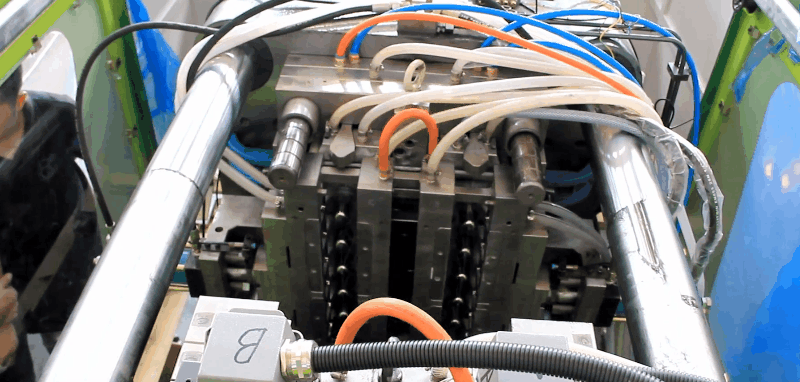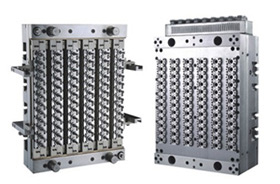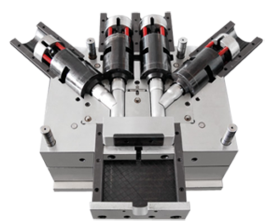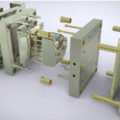Plastic Extrusion Blow Molding Process Extrusion blow moulding process is the largest and the earliest type of blow molding method. It is used to create hollow plastic products. It is suitable for the blow molding of polymers such as PE, PP, PVC, thermoplastic engineering plastics and thermoplastic elastomers, and various plastic blends. Used to produce packaging containers, storage tanks and other industrial parts. Extrusion blow molding process is start from the material is melted and plasticized in the barrel. And then extruded from the head of the extruder with conventional downward tube. When the hube parison reaches a predetermined length, a section of tube embryo is intercepted and placed in the blow mold while still hot. The mould is closed catching and holding the neck end open and pinching the bottom end closed. the compressed air blown into the parison through the air blowing nozzle The tube prison will be precisely inflated as the desired shape of the mold cavity. After the mould is completely cooled and then the mold can be opened to take out the product. Advantage and
Read more →Plastic Injection Blow Moulding Process Injection blow moulding process can be separated as injection moulding process and blow moulding process. 1. Injection moulding process: The injection molding is finished by an injection molding unit or machine. In this process we will produce a semi-finished product called preform or parison. Raw material is melt in a barrel and feed to the nozzles, injection to a injection mold, then we have the perform with kinds of bottle neck types. 2. Blow Moulding process: The blow molding is we put the performs or parisons to a blowing mold and use high pressure air to blow it up as a bottles or other hollowed containers. Now you know exactly two steps injection blow moulding process. And you can see we will need two main machines: injection molding machine and blow molding machine. It is a bit comples to produce a bottle or container but running very fast and have huge output capacity. This two step injection molding process is mostly use for PET bottles and containers manufacturing (Water bottles, soft drink bottles, edible oil
Read more →Advantages and Disadvantage of hot runner system Many customers ask us what is the advantages and disadvantage of hot runner system on plastic injection mold? Here we list some of the hot runner`s advantages and disadvantage for your information. ◆ Advantages of hot runner system (1) No nozzle material, no post-processing is required, so that the entire molding process is fully automated, saving working time and improving work efficiency. (2) The pressure loss is small. The temperature of the hot runner is equal to the temperature of the injection nozzle of the injection molding machine, which avoids the surface condensation of the raw material in the runner and the injection pressure loss is small. (3) The repeated use of nozzle materials will degrade the performance of plastics, and the use of hot runner system without nozzle materials can reduce the loss of raw materials and thus reduce product costs. The temperature and pressure in the cavity are uniform, the stress of the plastic parts is small, and the density is uniform. Under a lower injection pressure and a shorter molding
Read more →It is very important for PET preform Mould Lubrication System which have sufficient stiffness and strength. There are many factors should take care for a mold maker when starting a PET perform mould designs. The lubrication system of the mold plays a vital role in the PET preforms mould quality. It is the key in the PET preforms forming process. The material used for PET performs mould should be strictly select with considering their characteristic. Each part should be helpful for the mold gliding property, stability, accuracy, stiffness and strength, etc. There are two major categories for a mold making materials: metal and metal materials. The metal materials is mostly includes different no. of steel, aluminum alloy, etc. And the non-metallic materials are mainly have gypsum, cement, FRP, wood and so on. No matter what materials is used, but the preform mold must meet below requirements: 1. Reach the PET performs` accuracy of size. This is the basic rule you should keep in mind during the whole process of a PET preform mould design. 2. Make sure the mold have
Read more →Plastic mold is an abbreviation of molds includes compress molding, extrusion molding, injection molding, blow molding and low foam molding. It is a tool to make a fixed shape products with kinds of plastics. The tool is mostly have two parts called male mold and female mold. There is some empty space after the male mold and female mold closed. That is the plastic product`s shape. We put some melt plastic to fill the empty space and then we got a plastic part after it was cured. Please refer to below picture to help you understand the plastic mold definition. A series of plastic parts with different shapes and different sizes can be produce by changing the mold convex and concave molds and the auxiliary molding system. Plastic molds is the base factor of modern industry, and the release of new products will involve plastics parts. Plastic Mold Structure Plastic molds mainly includes a concave mold with a variable cavity composed of a concave mold combined substrate, a concave mold assembly and a concave mold combined card board, a convex
Read more →PET Bottle Blowing Troubleshooting is a skilled work needs lots of professional acknowledge on PET treatment process, bottle stretch blow molding machine and other auxiliary equipment. The production engineer should know much about PET preform treatment for the storage and tranportation, PET bottle blowing machine`s electronic circuit information,electrical diagram,hydraulic diagram, infrared heating system, compressed air drying system and other automatic controlling systems. Below we had listed the common pet bottle manufacturing defects and solutions of PET bottles blow molding for your checking. Feel Free to Contact Us if Any Questions
Read more →PET Preform Heating Temperature is about 75°C to 130°C on the preforms. So it will need to be adjusted according to the PET preforms` height, thickness, workshop indoor temperature, etc. A reheating step is then necessary to condition the preforms to the appropriate temperature distribution (slightly above the glass transition, which is typically ~75°C). This stage is generally performed using infrared (IR) heaters, taking advantage of the semi-transparent behavior of PET with regard to IR radiation. the objective function is reduced by 60% of its initial value after the first iteration, and by more than 80% at the end of the optimization process. Consequently, the thickness distribution of the formed bottle is 80% more uniformed after optimization. The algorithm converges after five iterations, which involves only 10 objective-function evaluations (that is to say, 10 FE simulations). On average, one cost-function evaluation requires 26 min CPU. Thus, the total CPU time required for the optimization is ~ 3 h 20 min. PET Preform reheat Temperature versus time inside and outside of the PET preforms for the oven configuration from publication. PET
Read more →It is important to select suitable models of plastic machinery for your plastic products. You will learn 7 proved procedures to choose right models of injection molding machines. Meanwhile, you will grasp 4 ways to calculate locking force of clamping units. You will be an expert in selection of models after minutes-reading. In general, most customers who have been in plastic industry for many years have the ability to select suitable model of plastic injection machines for their own projects. But sometimes, customers will require support from us, the manufacturers of plastic injection moulding machines to give suggestion on correct models of machines. Sometimes, customers only have samples in hand or just idea of new item in their brains, and then they need to be sure if our machines can make their new products or which model is best. And customer maybe require complete solution for efficient production. For example, for some special plastic parts, the production line will require accumulator, close loop, injection compress, etc. So, it is very critical to select right model of plastic injection machines. We
Read more →PET injection molding process is one of the very important technology for plastic processing.This blog systematically introduces PET processing by plastic injection molding machines. The content includes PET property, features, injection molding process, molding machines, process conditions, processing ways,etc. It will help PET making factory get useful knowledge in few minutes. PET plastic injection molding process is one of the very important technology for processing plastic, PET plastic bottles, most of the plastic packaging plant will adopt blow molding production process, but the injection molding process has especially the unique processing advantages. For PET for injection molding, technical personnel need to consider many factors. PET plastics introduction PET chemical name is Polyterephthalate alcohol ester, also known as polyester. At present, the most used by customers is the GF-PET, mainly for the bottle preform. The rheological property of PET is better in the melting state, and the influence of pressure on the viscosity is larger than that of the temperature. Therefore, the property of flow of melted material is changed mainly from the pressure. PET features & property: The glass conversion
Read more →We spend more than two weeks to edit this PET preform troubleshooting guide for PET injection Molding. As many customers asking us a lot for PET preforms defects and remedies again and again. Now it`s public for reading and hope this article can help our customers and friends and save both our times. Please feel free to contact us or leave your comment after the article if your issue is not list in below table. We will check and find out the solution for you. And update this table to help most people to fix the problems. If the information can`t solve your problem or any issue on PET preform troubleshooting, please leave us a comment for we can check and update the solution for your information. Feel Free to Contact Us if Any Questions
Read more →In order to understand the PET bottle neck finish dimensions & PET bottle neck types, we need to know a number of things before talking the details. PET Bottle Neck Definition and Measurements The neck of the bottle is defined by its total height, its inner diameter, its outer diameter and its thread. The dimensions of a neck (expressed in mm). PET Bottle Neck Finish Dimensions Measurements “T” Dimension – The outside diameter of the thread. The tolerance range of the “T” dimension will determine the mate between bottle and closure. “E” Dimension – The outside diameter of the neck. The difference between the “E” and “T” dimensions divided by two determines the thread depth. “I” Dimension – The inner diameter of the bottle neck. Specifications require a minimum “I” to allow sufficient clearance for filling tubes. Linerless closures, with a plug or land seal, and dispensing plugs and fitments require a controlled “I” dimension for a proper fit. “S” Dimension – Measured from the top of the finish to the top edge of the first thread. The “S” dimension
Read more →Reaction Injection Molding Technique Introduction This process involves the high pressure impingement mixing of two or more reactive liquid components and injected into a closed mold at low pressure. With RIM technology, cycle time of 2 minutes and less have been achieved in production for molding large and thick parts. Principal plastic used is thermopolyurethane (PUR). other material s used are thermoplastic nylon; thermoset polyester and epoxy. The advantages of the RIM over injection molding include the molding of the parts larger than 10 pounds, they can be made on the production basis using thinner walls because of the lower processing viscosities, or using very thick walls because curing is uniform throughout the part. There are problems associated with this method, however. The lack of the suitable internal release has made the RIM process labor-intensive, but changes are now occurring to significantly reduce or eliminate this problem. The molded polyurethane faithfully reproduces the surface of the mold and tends to stick to them. Originally the application of the mold-release agents was necessary with each cycle of the RIM technology. After
Read more →






